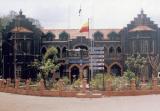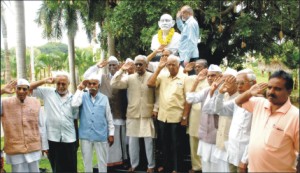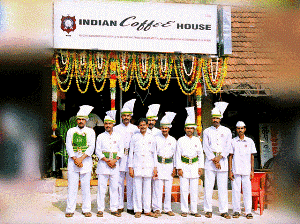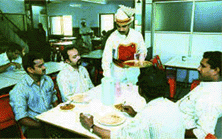Walkers are treated to a sprawling, lush MEG campus served up with a dash of history

With the army commemorating the first centenary of the First World War where many Indian soldiers sacrificed their lives, a part of the cantonment area opens up for the public to know its great history of which we can all be proud of. The Bengaluru walks, which have created a brand new way of rediscovering the city’s glorious past, has now added the Military Heritage Walk that takes you into the Madras Engineer Group (MEG) campus. The walk is actually a talk on the rich history of the military in which the Madras Sappers won wars from China to Egypt.
For the walkers, it is literally a treasure-trove of history. For example did you know the source of malaria was discovered in the army mess! Malaria, considered as one of the biggest killers mankind had ever known, was earlier believed to come from breathing in bad air from miasmic swamps. Ronald Ross had two stints in Bangalore. During his stay in the city, he used to dine at the Sappers and Miners officers’ mess where he observed larvae (on empty food trays left outside the mess) developing into mosquitoes. He suspected that the malaria vector was transmitted by the female anopheles mosquito. This observation, together with a number of experiments carried out later, and the publication of his papers led to him bagging the Nobel Prize for medicine/physiology in 1902 and subsequently to be knighted.
Vijay Thiruvady, who is known for his Lalbagh walks, introduced the Military Heritage Walk that takes us through the history of MEG, a history that traces back from 1780. The Sappers were affectionately called “Thambis” (meaning younger brothers in Tamil) by Major General Arthur Wellesley who went on to be the Duke of Wellington. Vijay says that the walks began in October this year and have garnered a lot of interest among Bengalureans. As this walk is held in the military area, which was not opened up to civilians previously, a strict security procedure is carried out.
The Sappers and Miners as an engineering enabling unit constantly used latest developments in their work. Bailey bridges developed by Sir Donald Bailey in the middle of the Second World War were quickly adapted by the Sappers. Post-independence, they built the highest Bailey bridge in the Khardungla pass at 18,300 feet. They have used Bailey bridges on every occasion including replacing the ineffective bridges at the New Delhi Common Wealth Games. Bengalureans can see the construction and dismantling of Bailey bridges on a continuing basis at Ulsoor lake.
The walk goes through selected areas of the MEG and Centre that reflect the history of the city. For example, Vijay says, the Britishers were very perceptive in their recruitment requirements. In fact, they recruited coconut gatherers and toddy tappers for their tough abdominal muscles. They had great skills, especially in scaling ladders for investing in fortification. The technique was used very successively in their operations at Savanadurga, Magdala, Burma and elsewhere. They also recruited fishermen for their exposure to sunlight, salt water and humidity that made their services invaluable and for their watermanship.
The highlight of the heritage walk is remembering the fallen at the war memorial to honour the brave Madras Sappers who laid down their lives in the First World War. None can ignore the horses that seem to pay their respects to the martyrs by not batting even an eyelid till the ceremony is over!
The best part about the walk is the serene climate of the cantonment because of the many trees there.
The tranquil atmosphere is a pointer to the city’s original charm of a Garden City. It leaves one wondering how nice it would be if the entire city was as green as the cantonment area. The MEG campus shows us how well the city could be maintained ecologically with care for greenery. For example, the oldest tree in MEG and Centre is a grand banyan planted in the 1820s, which is still giving plentiful shade.
A BRIEF HISTORY
WAR MEMORIAL
Erected in 1923, the Madras Sappers’ war memorial originally stood in a tree-shaded spot overlooking the Ulsoor lake. However, then it was decided to move the memorial to a less congested and more befitting surrounding.
DOOPTA
The head gear is one of the most attractive things of the MEG. Called the Doopta, it is adaptation of old Shakos without the peak and the chin strap. In the battle of Meanee in 1843 (today’s Pakistan), the Cheshire regiment were totally outnumbered in their fight against Balochis and Sindhis and were losing ground steadily till the Thambis, armed with just pikes, came to their rescue. Honouring their courage, troops of Cheshire regiment spontaneously removed their shakos (headgear) and presented them to the Thambis.
THE GREY MULE
It was the 150th anniversary of the pensioner’s reunion in the city during 1930 when a grey mule led the march. Wondering why a mule? Well, mules have been used worldwide. However, the story of this special Grey mule is remarkable. Commissioned into the service in 1891, the Grey mule served in Tirah, Chitral, Malakand, Tibet, Palestine and Egypt. In 1921, before the Sappers and Miners returned to India from Egypt, all the mules were sold off to the Egyptians. Colonel Basset requested to make an exception of the Grey mule, which was pensioned off and given freedom in the lines in our city. Hence, during the anniversary of the pensioner’s reunion, the Grey mule led the march-past accompanied by his Sapper handler and driver who had led him up the Malakand (North West frontier province in the Pakistan-Afghanistan border) 33 years earlier.
Amrit Mahal Bull
The Madras Sappers and Miners used the Amrit Mahal bull (a dwarf of the species) in the first Afghan War (1839-1842) for transporting a cannon and ammunition over the Bolan pass in Baluchistan. Major General Arthur Wellesley used it to great effect in the Battle of Assaye and elsewheree.
source: http://www.bangaloremirror.com / Bangalore Mirror / Home> Bangalore> Others / by Sridhar Vivan, Bangalore Mirror Bureau / November 03rd, 2014











